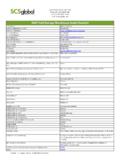Transcription of chapter 44 Medical stores management - WHO
1 Part I: Policy and economic issues Part II: Pharmaceutical management Part III: management support systems Planning and administration Organization and management 43 Security management 44 Medical stores management 45 Hospital pharmacy management 46 Pharmaceutical management for health facilities 47 Laboratory services and Medical supplies Information management Human resources management chap ter 44. Medical stores management Summary illustrations Information for materials management Figure 44-1 Checking received goods Manual versus computerized systems Procurement Figure 44-2 Storage and load-handling equipment information Stock records Performance monitoring Figure 44-3 Good stores management and reporting Communications Figure 44-4 Poor stores management Figure 44-5 Medical stores organizational chart Flow of stock and information Stock receipt Planning for space requirements Stock Table 44-1 Inspection checklist for medicine receipts storage Stock control using FIFO and FEFO Order Table 44-2 Temperature and security zones allocation Order picking Order assembly Order Table 44-3 Typical requirements for an
2 Effective cold dispatch and delivery Inventory taking chain Table 44-4 Contents of a procedures manual for a central Zoning stock within the store pharmaceutical supply system Storage at uncontrolled room temperature Storage at controlled temperature and humidity Cold b ox storage Secure storage Flammables Box 44-1 Examples of monitoring and evaluation targets Stock location within a zone and indicators Fixed location Fluid location Semifluid location Stock classification c ountry study Therapeutic or pharmacological category Alphabetical CS 44-1 Central Medical stores inventory control system order Dosage form Random bin Commodity code operations in Namibia Stock storage and handling Packaging specifications Shelving Floor annexes pallets Block-stacked pallets Pallet racking Load Annex 44-1 Sample stock record card handling Annex 44-2 Sample bin/stock card Housekeeping Annex 44-3 Sample receiving report Cleaning and pest control Inspection Disposal of Annex 44-4 Sample requisition/issue voucher Annex 44-5 Sample delivery voucher expired or damaged stock Fire precautions Security Annex 44-6 Sample register of requisitions Human resources management in Medical stores Staff training and the Medical stores procedures manual Staff supervision and discipline Career development Staff facilities Sanitary facilities Staff rest areas First aid References and further readings Assessment guide copyright management sciences for
3 Health 2012. Organization an d management s u mm a r y This chapter discusses Medical stores management at The following are characteristics of a well-managed central-level stores and at regional or district-level stores stores operation . that are independent from health facilities. This supply The store should be divided into zones that provide model represents the traditional top-down system that a range of environmental conditions and degrees of is operated by a governmental or parastatal entity or a security. nongovernmental organization; however, a number of There should be an appropriate zone to suit every countries have now decentralized many of their pharma- item to be stored. ceutical sector operations, including stores management .
4 Stock should be arranged within each zone accord- chapter 8 discusses supply chain options, including the ing to some orderly system. trend toward decentralization. In addition, many supply Stock should be stored off the floor on pallets, on systems contract out certain operations to private-sector pallet racks, or on shelves. Each of these systems companies. Managing contracts requires skills such as requires specific types of handling equipment. defining and monitoring performance indicators and Good housekeeping cleaning and inspection, the negotiating payment and service terms. See chapter 39. disposal of expired and damaged stock, recording for more information on contracting. The tenets of this of stock movements, and the management of secu- chapter , therefore, apply to stores operating in either the rity should be maintained.
5 Public (often called central Medical stores ) or nonpublic The management structure should be clearly sectors. defined. Medical stores management should assist both the flow Staff should be appropriately qualified, trained, dis- and reliability of supplies from source to user as eco nomi ciplined, and rewarded. cally and reliably as possible, and without significant Clearly written procedures and handbooks should wastage, loss of quality, or theft. The primary purpose be available. of a store is to receive, hold, and dispatch stock. This To promote efficiency, staff should have good work- materials management process is implemented through ing conditions and facilities. inventory control and warehouse management systems, Stock should be verified regularly and periodic which may be manual or computer based.
6 The primary audits should be conducted. purpose of inventory control is to manage stock and Although the essential characteristics of materials man- ensure the smooth flow of goods by determining what, agement are the same for all systems, the level of sophis- how much, and when to order stock. Consequently, it tication of Medical stores varies widely, and each store provides essential information for procurement manage- approaches its system and documentation differently. ment. Warehouse management comprises the physical Therefore, the basic features presented in this chapter are movement of stock into, through, and out of a Medical adaptable, depending on the complexity of the Medical store warehouse. The systems should also be designed to stores management operation.
7 Provide information for performance monitoring. Information for materials management 2. A warehouse management system monitors the physi- cal flow of goods within the system, such as receipts, The goals of Medical stores management are to protect storage, and issues. stored items from loss, damage, theft, or wastage and to 3. A performance monitoring system checks that the sys- manage the reliable movement of supplies from source to tems are operating effectively. user in the most economical and expeditious way. Effective management of information is the key to achieving these Information is essential to management (see chapter goals. The integrated process is known as materials manage- 49). Collecting, processing, and disseminating informa- ment.
8 A fully developed system has three key components tion may seem costly, but the cost of developing and main- taining an information system should be balanced against 1. An inventory control system ensures that the right the costs of ineffective inventory control (see chapter 23). goods are acquired, in the correct quantities, monitors The design of the information system is important, but its their quality, and minimizes the total variable cost of success depends primarily on well-trained, organized, and operations (see chapter 23). supervised staff. Country Study 44-1 describes some of the 44 / Medical stores management inventory control system challenges to the central Medical to be accomplished more rapidly, accurately, economically, stores in Namibia.
9 And flexibly. Even with a computerized system, data must be entered, manipulated, and interpreted by skilled and Manual versus computerized systems knowledgeable staff. The information system must include data on products Procurement information entering and leaving the warehouse, products in stock, products on order, and ways to monitor the progress of The procurement process (Chapters 18 21) involves medi- orders in the supply pipeline. Key elements of the system are cal stores input at all levels of the distribution system. These well-designed forms, computerized information systems, inputs are described below. and clearly defined procedures. Procurement can be handled from a department within Two decades ago, most public supply systems relied the Medical stores or from an external unit.
10 The Medical completely on manual stock records, but now, many pro- stores unit provides the (internal or external) procurement grams have changed to computerized systems. Even with unit with a list of the types and quantities of medicines computerization, however, many countries still maintain needed for its operation. After a supplier is selected and a a manual system, such as bin cards, as a backup, espe- purchase order is placed, the procurement unit informs the cially during the transition to computerization. There is a Medical stores unit about suppliers, unit prices, the quanti- widely held belief that computerization solves the problem ties on order, the expected arrival dates of shipments, and of inventory control.










